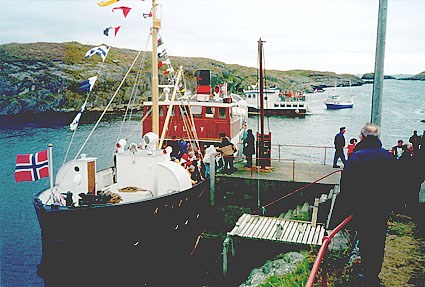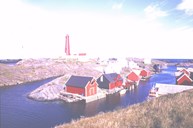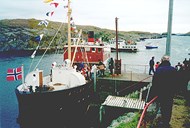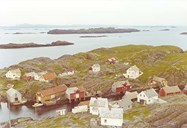The westernmost lighthouse in the country
The Utvær lighthouse was made operational on 15 November, 1900. It is a cast-iron construction and, before it was badly damaged in 1945, had two upstairs galleries. A so-called 1st order lens was delivered from Paris and became an attraction at the Bergen Exhibition in 1898.
To the south of the lighthouse a house was built with three lodgings: for the lighthouse keeper, his assistant, and a standby assistant. A big outhouse was also built, in addition to a boathouse in a sheltered harbour about 150 metres from the lighthouse. In 1940-41, a bomb shelter was built in rock under the lighthouse. The lighthouse station had its own generator in reserve during the years Utvær relied on power transmission from the mainland.
The bay of Utværvågen looked like a naval harbour
During World War II, all the lighthouses along the Norwegian coast were not operational, including Utvær. The lighthouse station, however, was manned by the lighthouse keeper. In the early stages of the war, the Germans realized that they had to keep a better watch along the western part of the Solund archipelago. During the incredibly rich herring fisheries in January, 1944, so many fishing vessels used the Utværa harbour that it was impossible to keep control. Consequently, the Germans decided to get a foothold on the island and took over the lighthouse station in February, 1944. The lighthouse keeper then had to move out. The Germans built a bunker above the bomb shelter. Two anti-aircraft guns were installed on the premises, and German naval vessels were frequently seen in the harbour.
The lighthouse station in flames
About a year after the Germans took over the lighthouse station, there was an English air raid from the east. The anti-aircraft guns had a blind zone in that direction because of the houses, so the Germans were unable to retaliate. The tower was turned into a smoking ruin. All combustible parts of the lighthouse tower were lost in the flames, and the upper part of the tower was particularly badly damaged. The house of the lighthouse keeper burned down, and the German officers and soldiers struggled desperately to roll out the petrol barrels stored there. The outhouse burned down, and three Germans lost their lives.
After this air raid, the westernmost signal station was barely operational. The Germans put a roof over the foundation wall of the keeper's house, where they lived in primitive conditions until the war came to an end.
A fine centenary celebration
A major restoration work was completed in 1952. The lighthouse tower was reduced by one floor, and had a different look at the top with only one gallery. A radio beacon was installed in 1954.
At first the light blinked by means of heavy weights hoisted up to the top by the lighthouse crew. The technical progress leading up to automation has been formidable. Even for the Utvær lighthouse it will perhaps only be a question of time before the light rays will sweep out to sea from an unmanned station.
On 15 November, 2000, 350 persons turned up to take part in a memorable centenary celebration on the island of Utvær. The day coincided with Norway Post's annual Stamp Day.







